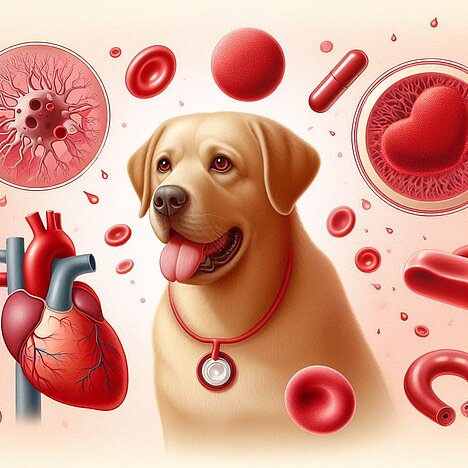Anticoagulants

Anticoagulants are drugs that inhibit or slow down blood clotting. They are often used to treat or prevent thromboses, embolisms or heart attacks. But how do they work in dogs? And when are they useful or dangerous?
How anticoagulants work
Anticoagulants intervene in the complex process of blood clotting, which consists of several steps. Various factors are activated which ultimately lead to the formation of a fibrin network that stops the bleeding. Anticoagulants can act at various points in this process and interrupt or slow it down.
There are different types of anticoagulants that contain different active ingredients. The best known are
- Heparin: A natural molecule that inhibits the activity of thrombin, an important factor in blood clotting. Heparin is usually administered as an injection and works quickly, but only for a short time.
- Warfarin: A synthetic molecule that prevents the formation of vitamin K-dependent coagulation factors. Vitamin K is an essential vitamin that is required for blood clotting. Warfarin is taken as a tablet and has a slow but long-lasting effect.
- Clopidogrel: A synthetic molecule that impairs the function of platelets. Platelets are small cells that stick together in the event of an injury and initiate the clotting process. Clopidogrel is taken as a tablet and has a medium-fast and medium-long effect.
Use of anticoagulants in dogs
Anticoagulants are rarely used in dogs as they have a high risk of side effects. The most common side effect is an increased tendency to bleed, which can lead to severe or life-threatening bleeding. In addition, anticoagulants can interact with other medications or foods and increase or decrease their effect.
Anticoagulants are only used in dogs in certain situations, for example
- For heart disease that increases the risk of thrombosis or embolism. For example, in cases of cardiac insufficiency or valvular heart disease.
- In case of poisoning with rat poison, which also contains warfarin. In this case, the rat poison must be antagonized with vitamin K to prevent fatal bleeding.
- In the event of surgery or trauma that may cause a temporary blood clotting disorder.
Dosage and control of anticoagulants in dogs
The dosage of anticoagulants in dogs must be adjusted individually, depending on the weight, health status and the aim of the therapy. The dosage must be checked and adjusted regularly to achieve an optimal effect and avoid side effects.
Anticoagulants in dogs are monitored by blood tests that measure the clotting time or clotting factor. These tests must be carried out in a specialized laboratory and are often expensive and time-consuming. The frequency of testing depends on the type of anticoagulant and the reason for use.
Precautions for the use of anticoagulants in dogs
The use of anticoagulants in dogs requires careful monitoring by the veterinarian and the owner. The following precautions should be observed:
- Follow the veterinarian's instructions exactly regarding dosage, time of administration and duration of therapy.
- Inform the vet of any other medications or supplements your dog is taking as they may interfere with the effect of anticoagulants.
- Avoid giving your dog foods that are high in vitamin K, such as green leafy vegetables, liver or eggs, as they can weaken the effect of warfarin.
- Watch your dog for signs of bleeding, such as pale mucous membranes, blood in the urine or feces, nosebleeds or bleeding gums. If you notice any bleeding, take your dog to the vet immediately.
- Avoid exposing your dog to unnecessary injuries, such as sharp objects, rough play or fighting with other dogs. If your dog is injured, try to stop the bleeding and see a vet.
The authors assume that a veterinarian should be consulted if an animal is ill and that medication should only be taken after consultation with a doctor or pharmacist. Only an individual examination can lead to a diagnosis and treatment decision.
We help you find the nearest vet → This way